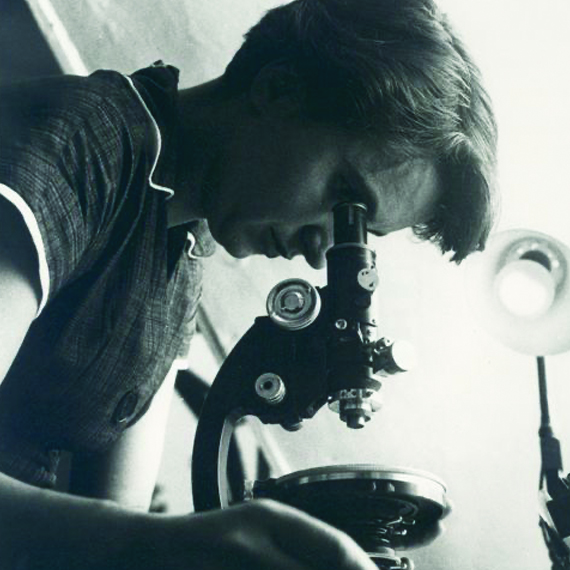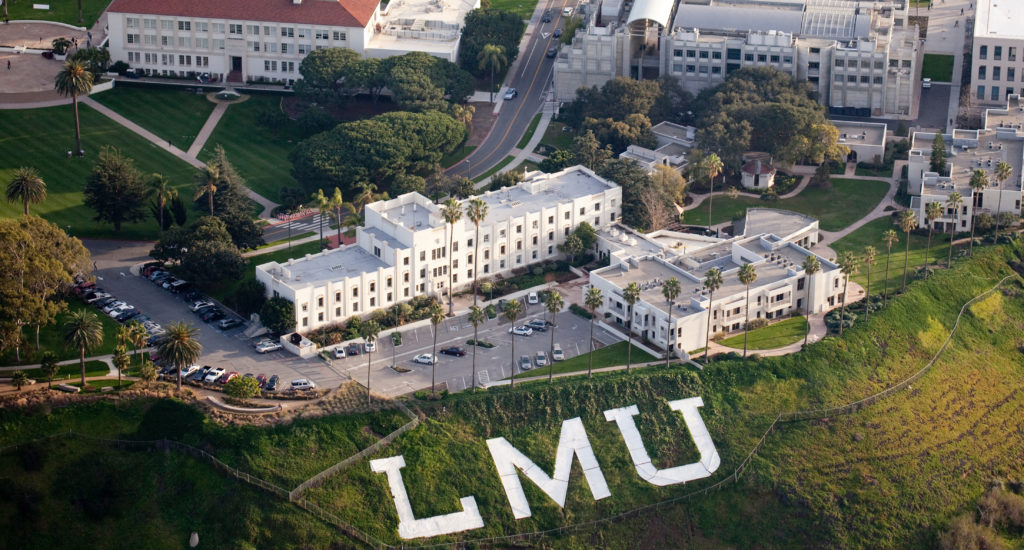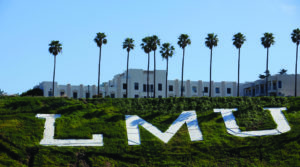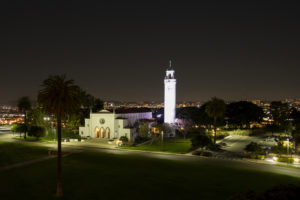Source: Jewish Women’s Archive. “Rosalind Franklin with Microscope in 1955.”
Written by Reed Jones ’24
Edited by Kennedy Wheatley and Velitchka Kaltcheva
Editor’s Note: When Reed Jones submitted this remarkable story in a First Year Seminar class, she never expected her work to be featured by the university. We had never heard of Rosalind Franklin before and wanted the chance to share Reed’s work on Rosalind Franklin’s story with the LMU community, bringing this important history to light.
At age 15, Rosalind Elsie Franklin knew that she wanted to be a scientist, but little did she know the enormous impact her work would have upon the world. She contributed to a groundbreaking discovery in genetics that would forever be remembered in the history of science – but without her name attached. In her short lifetime of only 37 years, Rosalind Franklin produced research that led to a Nobel Prize, yet she was not one of the awardees.
Born on July 25, 1920, she grew up in the flourishing neighborhood of Notting Hill, London, one of five children in an affluent Anglo-Jewish family. Rosalind’s bright mind and independent spirit were evident from a young age. Her sister Jenifer recalls her beginning to talk very early; at age 2, she was already teasing her older brother. When she first learned about God, she was quick to question his gender.
At age 11, Rosalind excelled at the academically rigorous St. Paul’s Girls’ School and was particularly drawn to the sciences. Her sister Jenifer wrote, “many traits of her character were already clear – her intelligence, her skills with her hands, her perfectionism, her logical mind, her outspoken honesty” (Glynn, 26). Rosalind studied diligently and won an unusually large number of academic prizes at this competitive school; her school certificate noted six academic distinctions. Education was extremely important in her family, for both the men and the women. Rosalind was expected to attend academic schools and to finish university.
She pursued her love of science in her undergraduate and graduate studies, majoring in chemistry at Newnham College in Cambridge. Her friend Gertrude Dyche (nee Clark) remembers Rosalind, “She was straightforward, even forthright, and not inclined to be diplomatic. She had very high standards and expected others to have the same” (Glynn, 41). Rosalind joined the Chemistry Society and the Archimedians (the math club). After earning her B.S. degree, she accepted a position as an assistant research officer at the British Coal Utilisation Research Association. Her research there led her to earn her Ph.D. in physical chemistry in 1945.
After earning her Ph.D., Franklin began working at the Laboratorie Central des Services Chimiques de l’Etat in Paris, France at the recommendation of Marcel Mathieu, a French scientist she met at a conference. She was one of the small percentage of females working in scientific laboratories at that time.
It was at Laboratorie Central that Franklin became fascinated with crystallography. Sometimes called X-ray diffraction, this was a technique used to determine the atomic structure of crystals. At Laboratorie Central, Franklin’s perfectionism was an asset; she labored to master this delicate and difficult process.
In 1951, a scientist named Maurice Wilkins working at Kings College laboratory heard about Franklin’s expertise with X-ray crystallography and sought her out to join his research team. Like many other scientists in the 1950’s, he was racing to discover the structure of DNA, the key to unlocking the human genetic code. Wilkins thought that X-ray crystallography might provide some clues, but his work in this area so far had been unsuccessful. He had failed to produce X-ray crystallography photographs that resulted in any usable data.
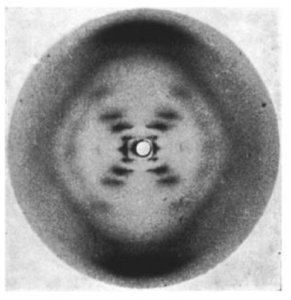
Wilkins was out of town when Rosalind Franklin was hired, and their first meeting did not go well. He mistook her for a new secretary, and it appears that they never established a good working relationship as fellow scientists. Franklin had gotten the impression she would be working alone in the lab; Wilkins saw her in a more supportive role to his work. In Wilkins’ later memoir, he referred to Franklin as “Rosy,” complaining that she had an attitude and was too independent.
After about a year at Kings College laboratory, Rosalind Franklin and her Ph.D. student Raymond Gosling took the X-ray crystallography photograph that made history and is still studied in textbooks today. Known as ‘Photograph 51,’ it clearly shows the double-helix structure of DNA and the genes contained inside. This photograph combined with all the research was enough to create a model that would change all scientists’ understanding of DNA.
What happened next is still a subject of great debate. Wilkins may have shared the photograph and research with two other scientists, James Watson and Francis Crick, who were working at Cavendish Laboratory in London and were also racing to crack the DNA code. Most historians believe that Rosalind Franklin did not know that her data had been shared with other scientists. Others argue that that Franklin’s work was not confidential; Watson and Crick found it in a public setting and did not ‘steal’ anything from her.
One year later, in 1953, Watson and Crick made scientific history by publishing a new model of the DNA code, including the crystallography photograph and Franklin’s research. Wilkins was included as one of the researchers. Rosalind Franklin was not credited for her contribution — or even mentioned.
The photograph captured by Rosalind Franklin and Raymond Gosling was revolutionary – not only for the scientific community, but for the world. This photo was the missing piece of the puzzle that enabled scientists to fully understand DNA, which in turn transformed their understanding of genetics. Photograph 51, according to Geoff Bowell, an archivist at King’s College, “is arguably the most important photo ever taken” (Walsh).
What was Franklin’s response when she discovered that her groundbreaking photograph had been published without her permission or a proper credit? There is no documentation of Franklin complaining about not being credited. However, shortly after the paper was published, Franklin left the Kings College laboratory and went to Birkbeck College to set up her own research lab. There, she began a collaboration researching the structure of viruses with a scientist named Aaron Klug, who won the Nobel Prize in Chemistry in 1982.
Franklin reportedly had a lot of respect for both Watson and Crick, did not resent their success, and was even friendly with Crick and his wife. In fact, she had submitted her own
DNA research paper to one of their colleagues, Max Perutz, who was head of the Medical Research Council. The data in her notebooks was not far from the model offered by Watson and Crick; scientists note that she was only slightly behind them in her research.
Several years later, while on a trip to meet with scientists in the U.S., Rosalind Franklin fell seriously ill. She was diagnosed with ovarian cancer. She fought the disease for a year, and passed away on April 16, 1958.
In 1962, a decade after Franklin captured the famous ‘Photograph 51,’ Watson, Crick, and Wilkins were awarded the Nobel Prize for Physiology or Medicine for discovering the spiraling ladder helix structure of DNA and its role in heredity. Franklin received no credit for her crucial contribution to this discovery until years after her death.
In 1968, Watson published his memoir revealing that Rosalind Franklin was the scientist who contributed the crucial X-ray crystallography photograph. In 1962, when the three men were awarded the Nobel Prize, the rules stated that only three people could be awarded a single Nobel Prize, but allowed that an additional person could be awarded the prize posthumously. Sadly, this rule allowing a posthumous award was eliminated in 1974, making it impossible for Rosalind Franklin to be awarded the Nobel Prize despite new evidence about her crucial contribution.
There is great controversy about this history; was Rosalind Franklin robbed of the Nobel Prize? Was she denied recognition because her contribution to unlocking the structure of DNA was not essential … or because she was a woman?
Many believe that Franklin should have been credited for her X-ray crystallography research and deserved to be recognized with a Nobel Prize. Kiona Smith argues that Franklin was an essential contributor to the discovery of DNA’s structure; her X-ray crystallography was the final piece of the puzzle that unlocked scientists’ understanding of DNA. She views Franklin as an equal to her male colleagues and worthy of being honored at the same level.
Biologist and Franklin historian Lynne Osman Elkin also supported the view that Franklin should have been recognized alongside her colleagues. Elkin participated in a scientific panel that reviewed Rosalind Franklin’s history and her role in the discovery of the structure of DNA. Elkin notes that a number of Franklin’s publications were on the cusp of discovering the structure of DNA, and although she did not fully solve the structure, her work still should have been referenced as a crucial contribution to the discovery of the structure of DNA.
Other scientists believe that the use of Franklin’s data without any credit was acceptable and the distribution of the Nobel Prizes was appropriate. Widely published zoology professor and genetics scholar Matthew Cobb states that the idea that Watson and Crick stole Franklin’s data is false, as the information was not confidential. Cobb does agree that Franklin’s work was crucial; however, he does not challenge the Nobel Prize distribution.
New York Times science reporter Nicholas Wade also supports the decision to award Watson, Crick, and Wilkins the Nobel Prize. Wade claims that Crick saw ‘Photograph 51’ in an annual report at a public lecture, which made his use legitimate. Wade viewed Franklin as a contributing member of the team, but claims that she did not understand enough about the DNA structure to be considered one of the awardees of the Nobel Prize.
The question of plagiarism is a critical one here, as most historians agree that the research was private. Franklin was unaware that Wilkins, Watson, and Crick had used her X-ray photograph and thus they did not receive her permission to use her data. Not only did they use her photograph, but they published their findings without any mention of Franklin. Smith wrote, “Wilkins shared the Nobel Prize in Physiology or Medicine with Watson and Crick for discovering the spiraling ladder structure of DNA and its role in heredity. Franklin, whose lab produced the photograph that helped unravel the mystery of DNA, received no credit for her role until after her death” (Smith). This is quite literally the definition of plagiarism, yet the entire scientific community has been quiet on this issue. This poses the question raised by Smith, the scientific panel, and Cobb — was there sexism involved in excluding Franklin from the credit?
Smith does not explicitly state that Franklin’s exclusion was caused by sexism. However, she does note that Watson “did not like Franklin” (Smith). Watson did finally give her credit in his publication epilogue; after Franklin’s death and after he had received the Nobel Prize.
Elkins believed that Franklin was not treated well, and certainly not as an equal to her colleagues. She believes that due to the pervasive sexism within the scientific field, Franklin was unaware that she should have been treated better. She claims that Franklin’s paper was not acknowledged, “… because of the snaky deal that was done between Randall, the head of King’s, and Bragg, the head of Cavendish (Laboratory), to cover up the very awkward fact that the data had migrated from one place to the other” (Lloyd). This statement suggests the questionable activities not only of Watson and Crick but also of their superiors.
Others refute the idea of potential sexist intent behind the actions of Watson, Crick, Wilkins, and the Nobel Prize Committee, or struggle to reconcile what occurred. Cobb freely admits that there is sexism in the field of science. In fact, he states that even if Rosalind Franklin had still been alive in 1962, she would not have been awarded the Nobel Prize due to sexism ingrained within the scientific field. But then he contradicts himself, stating the following about the issue of crediting work, “What Watson and Crick needed was far more than the idea of a helix — they needed precise observations from X-ray crystallography. Those numbers were unwittingly provided by Franklin herself, included in a brief informal report that was given to Max of Cambridge University. Their behaviour was cavalier, to say the least, but there is no evidence that it was driven by sexist disdain: Perutz, Bragg, (director of the Cambridge lab) Watson and Crick would have undoubtedly behaved the same way had the data been produced by Maurice Wilkins.” (Cobb) This is an odd argument to make since Wilkins was given credit for all the research coming from his lab, including Franklin’s, and was awarded a Nobel Prize.
Wade makes a particularly curious argument; noting that because Franklin was not aware her data had been shared, she was blissfully ignorant and did not feel like she had been wronged. This argument appears to be refuted by the fact that Franklin left Kings College lab shortly after her groundbreaking photograph was published without giving her credit. The timing does not seem coincidental.
Wade also states that Franklin was detrimental to the King’s research team as a whole because she did not communicate with Wilkins. Wade believes that if she had collaborated with Wilkins throughout the research, the Kings College laboratory would have been the one to publish the model of the structure of DNA and make history.
It is worthwhile to reflect on the charge in Watson’s memoir that Rosalind Franklin was difficult to work with. Was her behavior considered offensive because she tried to stand up for her right to be treated as a scientific equal? Was her desire to focus on her own research in the 1950’s considered inappropriate behavior for a woman? It appears that Franklin had good relationships with some of her male scientific colleagues, as she went on vacation to Italy with Klug and his wife. It is difficult to know how Franklin’s relationships with Wilkins, Watson and Crick played a role in her being denied credit for her research, and thus failing to be recognized by the Nobel Committee when they awarded the three men the Nobel Prize.
But no one can dispute this fact – without Franklin’s X-ray photograph and research, it would have taken Watson, Crick, and Wilkins much longer to discover and model the structure of DNA. Her work was a turning point not only in the scientific quest to unravel the mystery of the structure of DNA but also in the use of X-ray diffraction itself. Her name should be on Watson and Crick’s papers, on the Nobel Prize that she deserved to be awarded, and in textbooks, so all people know the name Rosalind Franklin and how her contribution changed the course of scientific history.
Access list of references here.
OIA Buzz
- Join us in congratulating Dr. Cheryl Grills, appointed President’s Professor in BCLA on March 16, 2021!
- Cheryl recently co-wrote an article for the Washington Post, on vaccine access for people of color. Read it here.
- This semester, the LMU LGBTQ Faculty & Staff Network is hosting “The Rainbow Hour,” a two-times-a-month gathering for LGBTQ+ faculty and staff. Register for the next event(s).
- Continuity of Community: Community Check-in Survey | Deadline March 26
The Community Check-in Surveys have provided a snapshot of how LMU is doing over the past year. The third community check-in survey will be open March 15-26. The surveys will continue to assess our virtual campus, sense of belonging, and perceptions of the university related to COVID-19 and racial justice. The second part of the October 2020 results – on gender identity, caregiver and disability status – will be available later this month. Other reports are available at the links listed below. Contact OIA@lmu.edu for questions.
We welcome all staff, students, and faculty to fill out the March 2021 Community Check-in Survey by Friday, March 26.
Access past survey briefings:
- Systemic Analysis:
Join us TOMORROW, March 24, from 11 a.m.-noon for a Systemic Analysis Consultation Workshop and receive access to the Systemic Analysis Brightspace course, which will provide a systemic analysis guidebook and equity scorecards for student, staff and faculty.
Attend the last Systemic Analysis Report Out session of the semester, on March 30, 2021 from 4-5pm. University Advancement and the College of Communication and Fine Arts and will present on unit systemic analysis and DEI work.
- You are invited to the Academic Community of Excellence Scholars Recognition Event on Friday, March 26, at 3:00 p.m. Join us as we recognize our academic achievers, graduating seniors, and alumni. RSVP by Wednesday, March 24th.
- In Six Words is still accepting submissions! View our current stories on the In Six Words web page, and submit your own story here.
